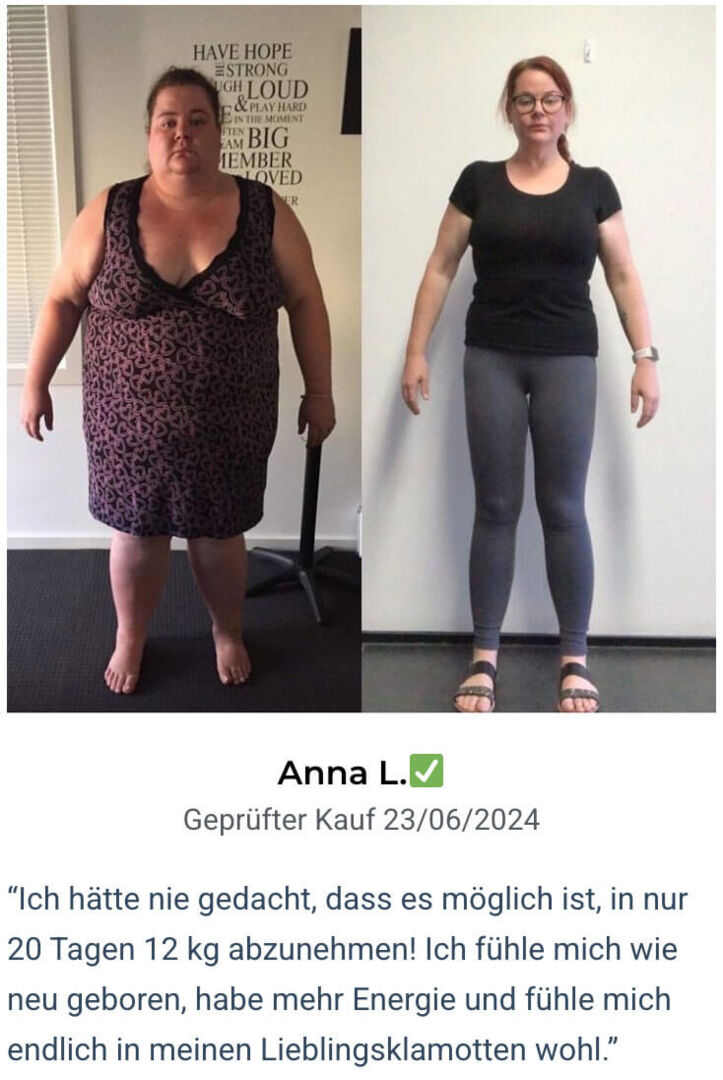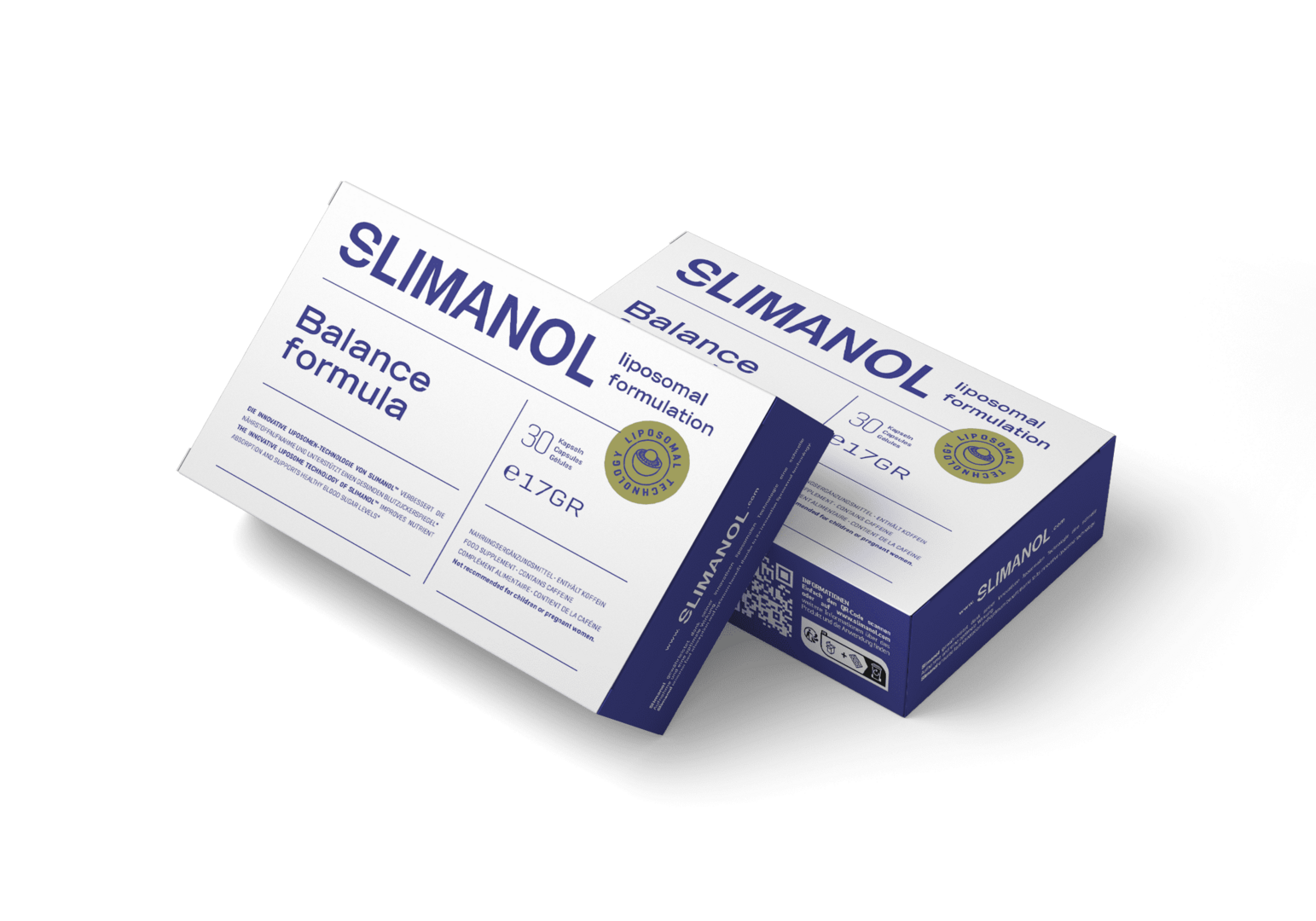vor 2 Tagen | Miachel Bachmann | Lesedauer: 5 Minuten
DAS GEHEIMNIS DER EXTREMEN GEWICHTSABNAHME, VON DEM DIE ÄRZTE NICHT WOLLEN, DASS SIE ES ERFAHREN!
Stellen Sie sich vor, Sie wachen jeden Morgen mit einem schlankeren, energiegeladeneren Körper auf, ohne dass Sie sich einer strengen Diät unterziehen oder stundenlang trainieren müssen. Klingt unmöglich? Jetzt nicht mehr.

“Ich habe in nur 30 Tagen 20 kg abgenommen… ohne Diät oder Sport!“
Dies ist ein Ergebnis, das Tausende von Menschen dank einer einzigartigen Entdeckung erhalten, die Experten auf der ganzen Welt verblüfft hat.
Laut einer neuen wissenschaftlichen Studie hängt der Grund für die Ansammlung von hartnäckigem Fett und zusätzlichen Pfunden mit einer versteckten Stoffwechselstörung zusammen, von der 9 von 10 Menschen betroffen sind.
Keine kalorienarme Diät, kein Fitnessprogramm kann das Problem lösen … bis Sie diese revolutionäre Lösung entdecken.
Der Wendepunkt
Nachdem ich jahrelang mit meinem Gewicht zu kämpfen hatte, hatte ich aufgegeben. Nichts hat funktioniert.
Doch dann entdeckte ich dank einer geheimen Studie von Schweizer Wissenschaftlern die natürliche Methode, die Ihren Stoffwechsel um über 311% beschleunigen kann – buchstäblich während ich schlief!
Diese Methode nutzt einen “einzigartigen Mechanismus”, der den Körper reaktiviert und es ihm ermöglicht, Fett wie nie zuvor zu verbrennen.
Wie funktioniert Slimanol?
Der Mechanismus, der die Gewichtsabnahme revolutioniert, heißt “Synchronisierte Thermogenese” , ein biologischer Prozess, der Ihren Körper in eine 24-Stunden-Fettverbrennungsmaschine verwandelt, sogar während Sie schlafen.
Die synchronisierte Thermogenese nutzt einen Cocktail aktiver natürlicher Verbindungen, die aus seltenen Quellen gewonnen werden und auf drei Schlüsselbereiche wirken:
1- Aktivierung brauner Fettzellen
2- Reduzierung von Cortisol, dem Stresshormon
3- Neuprogrammierung des Grundstoffwechsels
Riesige Versprechen? Ja. Gigantische Ergebnisse? Noch mehr.
- Anna aus Berlin: -12 kg in 20 Tagen
- Lukas aus München: 15 kg abgenommen, ohne ein Fitnessstudio zu betreten!
- Maria, 54, aus Hamburg: In einem Monat um die Hälfte abgenommen
Wir präsentieren: Slimanol
Die einzige natürliche Lösung, die die synchronisierte Thermogenese aktiviert und den Stoffwechsel ohne Diät oder Fitnessstudio um +311% beschleunigt
Wie funktionieren die Slimanol?
- Eine Tablette vor den Mahlzeiten einnehmen
- Vom ersten Tag an beginnt die synchrone Thermogenese und Ihr Stoffwechsel verbrennt überschüssiges Fett und Kalorien.
- Die Ergebnisse sind bereits nach wenigen Tagen sichtbar
Sie glauben nicht daran? Versuchen Sie es selbst
Laut einer Studie mit über 37.000 Probanden konnten 87% der Anwender eine Reduzierung des Fettgewebes innerhalb der ersten 3 Wochen beobachten. 84% der Anwenderinnen würden das Produkt weiter empfehlen.
Lassen Sie sich diese Gelegenheit nicht entgehen. Sie sind nur einen Schritt davon entfernt, sich für immer von Fettleibigkeit und Fett zu verabschieden. Die Zeit vergeht für alle, aber nicht für dich.



Super kapseln! Habe es nur einen Monat genommen und trotzdme 6 Kilo runter bekommen das reicht mir erstmal. 😂
Antwort · 12 · Gefällt mir · Beitrag folgen · 01.01.2025

Echt super meine liebe! Freundin hat mir die gegeben weil sie die bestellt hatte und eine Packung nicht mehr gebraucht hat und man merkt einfach nach dem 3. Tag wie gut es funktioniert. ❤️ LG Linda
Antwort · 15 · Gefällt mir · Beitrag folgen · 02.01.2025

Ich habe das mit dem Slimanol formel pillen auch gemacht am Anfang des Jahres. Super einfach und funktioniert wirklich gut.
Antwort · 6 · Gefällt mir · Beitrag folgen · 02.01.2025

Eben bestellt.... mal gucken was passiert...
Antwort · 2 · Gefällt mir · Beitrag folgen · 03.01.2025

Hey Jessi! Wie lange hat bei dir die Lieferung gedauert?
Antwort · 1 · Gefällt mir · Beitrag folgen · 03.01.2025

Hi Nina.... hat bei mir 2 Tage gedauert und die waren da... sehen echt super toll aus ich liebe es 🤩🤩
Antwort · 4 · Gefällt mir · Beitrag folgen · 03.01.2025

Also ich bin ja mal gespannt ob das wirklich so wirkt hört sich zu gut an um wahr zu sein
Antwort · 2 · Gefällt mir · Beitrag folgen · 03.01.2025

vielleicht einfach mal davon ausgehen das es stimmt weil es steht ja schliesslich auch auf einer gesundheitszeitung und das bestimmt nicht ohne grund wäre bessr einfach mal zu glauben
Antwort · 7 · Gefällt mir · Beitrag folgen · 04.01.2025

Hab ich schon Süsse.
Antwort · 3 · Gefällt mir · Beitrag folgen · 04.04.2024

Muss ich auf bestimmte Lebensmittel verzichten, wenn ich Slimanol nehme?
Antwort · 1 · Gefällt mir · Beitrag folgen · 05.01.2025

Ich habe vor einem halben Jahr einen Kurs von Slimanol eingenommen und 19 kg abgenommen. Ich habe nicht wieder zugenommen
Antwort · 4 · Gefällt mir · Beitrag folgen · 06.01.2025

Ich hab das von einer Freundin empfohlen bekommen und bin super zufrieden mit den Kapseln. Sind auch einfach zu Schlucken. Nebenwirkungen habe ich auch keine. Ist sehr angenehm für mich.
Antwort · 8 · Gefällt mir · Beitrag folgen · 06.01.2025

Nehme das Slimanol jetzt schon seit 15 Tagen und bin wirklich überrascht, den ich habe auch schon 4kilo verloren und habe auch keinen Sport gemacht und die Kilos sind trotzdem weg. Mit mehr Bewegung gehen die Kilos bestimmt noch leichter runter, versuche es mal.
Antwort · 2 · Gefällt mir · Beitrag folgen · 06.01.2025

Kann man diese Dinger auch als Mann nehmen?
Antwort · 1 · Gefällt mir · Beitrag folgen · 07.01.2025

Wüsste nicht was dagegen sprechen sollte... Stoffwechsel hat Mann und Frau ja quasi den selben 😉
Antwort · 1 · Gefällt mir · Beitrag folgen · 07.01.2025

Hab ich vorgestern bestellt und ist eben gekommen 😂 Hab auf MSN.de die Werbung dazu gesehen.
Antwort · 1 · Gefällt mir · Beitrag folgen · 08.01.2025







